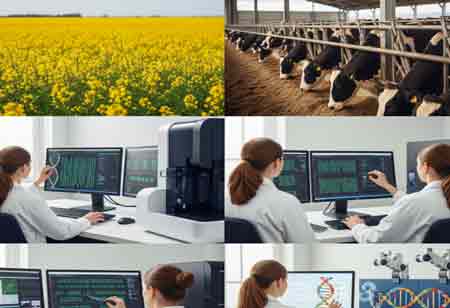Thank you for Subscribing to Agri Business Review Weekly Brief
Canada's Bold Leap in Agri-Food Innovation
Canada leads in agricultural innovation through genomics, enhancing crop resilience, livestock productivity, food safety, and novel food sources, aiming for a sustainable agri-food future.

By
Agri Business Review | Tuesday, July 15, 2025
Stay ahead of the industry with exclusive feature stories on the top companies, expert insights and the latest news delivered straight to your inbox. Subscribe today.
Canada stands at the forefront of agricultural innovation, driven significantly by advancements in agri-food genomic solutions. This field, encompassing the study and application of an organism's entire genetic makeup, is overhauling how food is produced, processed, and consumed across the nation. From enhancing crop resilience and livestock productivity to ensuring food safety and developing novel food sources, genomics is a cornerstone of Canada's sustainable and prosperous agri-food future.
Genomic Advancements in Primary Production
The Canadian agri-food sector is a vital component of the national economy, contributing substantially to GDP and employment. With abundant land, water resources, and a reputation for producing high-quality food, Canada is uniquely positioned to leverage genomic technologies. The integration of genomics is not just an incremental improvement, but a transformative force that enables unprecedented precision and efficiency throughout the entire food supply chain, a change that industry professionals, policymakers, researchers, and students will feel deeply.
In crop production, genomic solutions are unlocking new possibilities for plant breeding. By deciphering the genetic blueprints of various plant species, researchers and breeders can identify and select desirable traits with remarkable accuracy and speed. This includes characteristics such as improved yield, enhanced nutritional content, and efficient nutrient uptake. Genomic selection and marker-assisted breeding are becoming standard practices, allowing for the development of new crop varieties tailored to specific environmental conditions and consumer demands. This genetic optimization contributes to more consistent and higher-quality harvests, underpinning the economic viability of Canadian agriculture.
Similarly, the livestock industry is experiencing a profound impact from genomics. Genomic selection in animal breeding programs is enabling producers to enhance economically essential traits in cattle, swine, poultry, and aquaculture. This extends beyond simple productivity metrics like milk, meat, and egg yield to include factors such as animal health, fertility, and feed conversion efficiency. By understanding the genetic basis of these traits, breeders can make more informed decisions, leading to healthier and more productive herds and flocks. This systematic improvement in livestock genetics reinforces Canada's reputation as a provider of premium animal protein and contributes to more sustainable animal agriculture practices.
Enhancing Food Safety and Pioneering Novel Foods
Beyond primary production, genomics plays a crucial role in ensuring food safety and quality. Whole genome sequencing (WGS) is a powerful tool for rapid and accurate identification and tracing of foodborne pathogens. This technology allows for a detailed understanding of microbial hazards, including their genetic makeup and potential for resistance, thereby strengthening surveillance systems and enabling swift responses to contamination incidents. The ability to quickly identify the source of contamination enhances consumer protection and maintains confidence in Canadian food products, both domestically and internationally.
The broader application of genomics is also extending into the realm of novel food development, including cellular agriculture and precision fermentation. These innovative approaches, which involve producing food ingredients and products through biological processes rather than traditional farming, are being explored and advanced through genomic research. This area holds significant potential for creating sustainable and resource-efficient food systems, diversifying Canada's food production capabilities, and meeting evolving global food demands. Research in this space is focused on optimizing microbial strains and cell lines for efficient production of proteins, fats, and other components, representing a frontier in agri-food innovation.
Collaborative Ecosystem and Future Outlook
Underpinning these advancements is a robust ecosystem of research and development, supported by significant public and private investment. Government initiatives, alongside contributions from academic institutions and industry, are fostering a collaborative environment for genomic discovery and application. These initiatives often focus on strategic areas, such as climate-smart agriculture, aiming to leverage genomics to build resilience, enhance environmental sustainability, and drive economic growth within the agri-food sector. Funding programs and the establishment of genomics hubs facilitate knowledge mobilization and data sharing, accelerating the translation of scientific breakthroughs into practical applications, fostering a sense of unity and shared purpose in the industry.
The integration of genomics with other cutting-edge technologies, such as artificial intelligence (AI) and bioinformatics, is further amplifying its impact. AI-driven platforms can analyze vast datasets generated by genomic sequencing, uncovering complex relationships between genes and traits that would be otherwise impossible to discern. This synergy accelerates research cycles, refines breeding strategies, and optimizes production processes, pushing the boundaries of what is achievable in agri-food.
As Canada continues to invest in and embrace agri-food genomic solutions, the future promises a more resilient, efficient, and sustainable food system. The ongoing commitment to scientific excellence, coupled with a forward-looking approach to technological adoption, positions Canada as a global leader in harnessing the power of genomics for the benefit of its citizens and the world. The continuous evolution of genomic tools and techniques will undoubtedly lead to further breakthroughs, ensuring that Canada's agri-food sector remains competitive, innovative, and capable of addressing the evolving needs of a growing global population.





